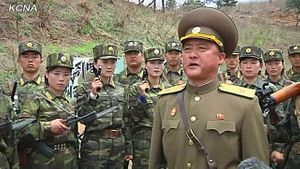Two North Korean militia units are fighting alongside Syrian government forces a representative of a Syrian opposition delegation claimed in Geneva this week, according to TASS.
Asaad al-Zoubi, a leading figure in the so-called High Negotiations Committee delegation, the Saudi-backed main opposition bloc, revealed the information amidst ongoing U.N.-sponsored peace talks on Syria in Geneva on Tuesday.
“Two North Korean units are there, which are Chalma-1 and Chalma-7,” al Zoubi said. According to the opposition, a former colonel in the Syrian Arab Army who now heads the Free Syrian Army in the south of the country, the North Korean fighters are “fatally dangerous.”
Since the beginning of the civil war in Syria, there have been repeated rumors of North Korean military involvement including the transfer of arms and the presence of military advisers in the country.
However, as of now, there is no hard evidence that North Korean troops are on the ground fighting alongside the pro-Assad forces or that Pyongyang is currently providing material support to the Syrian government.
Nevertheless, North Korean involvement is not impossible and there is a long history to Syrian-North Korean military cooperation as the U.S.-Korea Institute points out in an analysis.
North Korea over the last decades repeatedly supplied Syria with military hardware including armored personnel carriers, anti-tank weapons, rifles, and heavy artillery.
In the 1970s and 80s, North Korea also helped upgrade hundreds of Soviet-made T-54 and T-55 tanks in service with the Syrian Arab Army (including upgrading the turrets and equipping the armored vehicles with North Korean-designed laser rangefinders).
North Korea also supplied Syria with an unknown number of MANPADS (man-portable air-defense system), which are still in use as a 2014 picture of an ISIS fighter confirms.
In addition, North Korea sold Scud-C transporter-erector-launchers (TELs) and cluster warheads to Syria and allegedly also provided substantial technical assistance for Assad’s atomic and chemical weapons programs over the years.
North Korea has a history of boots on the ground in Syria. For example, Pyongyang sent 25 pilots to Syria during the Arab-Israeli War of 1967, 30 pilots during the 1973 Arab-Israeli (to both Syria and Egypt), and 40 pilots and 75 air force instructors in 1975 and 1976. The Korean pilots provided training and in some instances even flew combat missions against Israel.
During the 1980s, North Korea dispatched special operations forces to Syria to help train the conventional Syrian Arab Army and its allies in insurgency tactics. “In 1984-1986 and 1990, 50 and 30 North Korean military instructors were sent to Syria, respectively,” the U.S.-Korea Institute analysis elaborates.
North Korean soldiers allegedly also operated 122 millimeter truck-mounted multiple rocket launchers (the weapon systems were supplied by Pyongyang) during the 1982 Islamic uprising in the city of Hama. Up to 25,000 civilians were killed when Syrian government forces suppressed the uprising by indiscriminately shelling the city with artillery.
One of the key facilitators in the early stages of the civil purportedly was the late Chief of the Korea’s People’s Army Staff, General Kim Kyok Sik. Beginning in the 1970s, he served for over a decade as Pyongyang’s military attaché in Damascus.
Yet, have there been concrete examples of North Korean soldiers fighting in the ongoing civil war? There, the evidence is not conclusive.
For instance, the U.S. Korea Institute claims that during a 2013 battle North Korean soldiers were instrumental in defeating anti-government forces in a pitched battle. “Arab-speaking North Korean military advisors were integral to the operational planning of the surprise attack and artillery campaign execution during the battle for Qusair (…).”
Likewise in 2013, NK News cited Rami Abd-al-Rahman, the director of the Syrian Observatory for Human Rights, who said “that North Korean officers are taking part alongside the regular forces in the fighting in Aleppo.”
Furthermore, al-Rahman explained that “the overall number of these officers is unknown but there are certainly between 11 and 15 North Korean officers and the majority of them speak Arabic. . .(they) are deployed at several fronts such as the defense factories southeast of Aleppo and at the regular forces’ bases inside the city itself.”
Yet, there are no publicly accessible pictures of North Korean soldiers on the ground and no reports of North Korean soldiers killed, captured, or wounded in Syria.
What does North Korea get out of fighting on the ground alongside Assad forces?
First, North Korean soldiers can gain valuable combat experience which, among other things, can help inform future infantry tactics of the Korean People’s Army. Second, the North Korean military can also gain insights into irregular warfare tactics as practiced by the Syrian Arab Army, Hizbollah, and Iranian forces in Syria. Last, the battlefield in Syria can provide North Korean officers with insights how its own Soviet-era equipment would do in a war against Western military hardware.

































